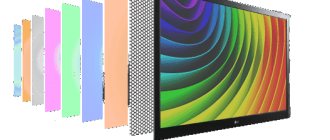About 10-15 years ago, any person coming to a store to buy a TV could not bother too much, since the basis of the assortment was CRT devices and flat plasma panels. Today, looking at the abundance of TV devices, a whole ton of questions arise, because from advertising posters and shop windows, incomprehensible designations UHD, OLED, HDR are thrown at the buyer... We haven’t yet gotten used to the new 4K resolution, but a new 8K is already looming on the horizon.
Moreover, it is not always obvious that the same technology can be called differently, while all of them promise a truly realistic picture when watching films. Let's try to understand all these designations and classify televisions according to the properties that are influenced by the technologies used in them.
What does a 4k TV represent?
The entertainment industry is moving the market forward by leaps and bounds. TV manufacturers are increasingly increasing the diagonals of TV screens, trying to meet the viewer's need to feel at home, like in a movie theater. The HD digital television format, which has become standard in many countries, can no longer provide an excellent image on the big screen.
There is a need to change the screen resolution by increasing the number of pixels per unit of screen area.
And in 2012, a technological leap occurs - Full HD with a resolution of 1920x1080 pixels is replaced by the 4K format (from 3840x2160 to 4096x3072) with its varieties.
- In terms of line length (screen width), 4K is twice as long as Full HD.
- The number of megapixels on the screen area is four (eight megapixels of a 4K format matrix versus two megapixels of the Full HD standard).
At the origins of the emergence of 4K, along with other equipment manufacturers, was the well-known company LG, which at one of the forums presented a TV with support for 3D and 4K Ultra HD.
Manufacturers began to use the term “4K Ultra HD” to refer to TVs with a high-definition resolution of 3840x2160 pixels. Strictly speaking, combining the two concepts of 4K and Ultra HD into one common name is not entirely correct, but nevertheless approved as a standard marketing concept by the International Consumer Electronics Association.
Image enhancement technologies
It’s not just the technology used in television screens that affects the quality of the final image. Software algorithms for image enhancement play an important role here. The most famous of them is high dynamic range technology or HDR, which is designed to make the image more detailed, thanks to the accurate depiction of all shades and smooth transitions between them. But few people paid attention to the fact that this option is designated by as many as three standards. What they mean is explained below.
HDR10
The HDR10 standard, which all devices bearing the Premium UHD logo support, is more than just HDR. The number 10 at the end indicates a color depth of 10 bits, which is characterized by better rendering of color tones. Even in night scenes, you will not see a black picture, but will begin to discern details. This technology is successfully used even in video games, enhancing the impression of what is happening on the screen.
HDR Dolby Vision
Dolby Vision provides the best HDR effect available today. It supports 12-bit color depth, and TVs require a separate hardware chip to play 12-bit video. As a result, TV devices that support HDR Dolby Vision will cost more, but will provide better display of tones and gradients.
Playing Dolby Vision videos on TVs that support HDR10 doesn't make much sense: if the TV has a 4K resolution, the image on it will look like you're watching extrapolated (stretched to a higher resolution) Full HD.
HDR10+
The standard introduced by Samsung could pose serious challenges to the previous two image enhancement algorithms. HDR10+ technology allows you to dynamically describe the contrast and colors of the image for each individual scene in real time, and not statically, as is the case with Dolby Vision and HDR10.
That is, this standard can significantly improve the dynamic range of color shades even in streaming broadcasts. However, for this to happen, online cinemas must support this standard. At the moment, only Amazon Video can offer this.
The difference between ultra hd and 4k
Let's look at the difference between UltraHD and 4K. The term "Ultra HD" has two meanings:
- An ultra-high definition television standard that replaced HDTV in Europe in 2021. In Russia and CIS countries, this standard is currently available only on a small number of channels. The first broadcast in this format was launched in 2013 by the operator Tricolor TV;
- One of several 4k resolution standards, differing in the number of pixels and screen aspect ratio.
The abbreviation 4K was initially used only in digital cinema, where resolution is determined by the long side of the frame. The term meant that the film frame shot for the film was 4000 pixels wide (the letter K stands for kilo). 4K resolution has six image sizes in pixels.
The most popular are three of them:
- Ultra HD - resolution 3840 by 2160 pixels, aspect ratio 16:9 (the entire matrix has eight megapixels);
- 4K (full frame) - 3996 by 2160 pixels, and an aspect ratio of 4:3 (matrix resolution - twelve megapixels);
- 4K (caged) - the resolution is the same as the previous one, 3996x2160 pixels, and the aspect ratio is Flat (with a matrix resolution of eight and a half megapixels).
When watching TV, the average viewer is faced with UHD resolution. The full-frame standard is used only in specialized devices; the other four are in cinema.
Display Manufacturing Technologies
The most well-known technologies used today for the manufacture of TV displays (as well as monitors and smartphone screens) are LED, OLED and QLED. They are based on LED semiconductors. They are environmentally friendly, safe and do not consume much electricity. What's the difference?
LCD displays
Liquid crystal LCD displays are the most common display devices.
As the name implies, they are based on liquid crystals, which are located in numerous types of matrices. But the crystals themselves do not glow, so modern TV panels use LED backlighting consisting of several LEDs. The main feature of such displays is the lowest pixel degradation. Such TVs can work for decades. Depending on the matrix technology, LCD displays can provide good viewing angles, high brightness and good contrast. And the cost of such devices is noticeably lower than high-tech delights, which we will discuss below.
OLED displays
OLED panels use so-called organic light-emitting diodes to transmit images. To create them, layers of film made from organic polymers are used, hence the name. OLED displays immediately attract attention with higher brightness and color images compared to traditional LCD screens. At the same time, their brightness range is very large, and they are the only ones capable of displaying true black color.
The viewing angles of OLED displays are better than those of LCDs (though the difference is not so critical): you will not see changes in color on the screen no matter what angle you look at it. The power consumption of OLED displays is also slightly lower, and their sizes are thinner, since they do not need additional backlighting. But the service life of diodes of some colors is very short (on average about three years of continuous operation), while the price of OLED TVs is noticeably higher than their LCD counterparts.
QLED displays
The technology for manufacturing QLED screens appeared relatively recently and was developed by Samsung. Despite its similarity with OLED, this technology, when designed for modern TV screens, is rather close to LED panels. Instead of an LED, a miniature crystal acts as a pixel, which is called Quantum Dot or “quantum dot”.
When exposed to electric current from the matrix, the crystals begin to glow and emit color. Colors may vary depending on the material from which the crystals are made. The obvious advantages of QLED displays are the expanded color gamut compared to LED panels and the lowest power consumption of all the above technologies. What is no less attractive is that the service life of such screens is higher than that of OLED panels (about 7 years of operating time).
4k ultra hd specifications
The key advantages of the technology are:
High image clarity - this directly depends on the pixel density per unit area (with a resolution of 3840 by 2160, the matrix contains eight megapixels). The image on a large diagonal TV screen, even at a distance of one and a half to two meters from the eyes, looks clear and contrasty.
Progressive scan - increased frame refresh rate (up to 100/120 Hz in flagship models compared to 50/60 Hz for HDTV).
- increases the quality of content playback, promotes greater clarity and smoother movements on the screen,
- reduces eye strain.
Saturation of colors. Previously, the bit depth was eight bits per pixel and made it possible to display about 17 million colors on the screen. Dolby Vision technology has made it possible to increase this figure to 12 bits - this is already shades of about 69 billion colors.
Using the HDR image enhancement algorithm. TVs can:
- “complete the picture” if the video was shot with equipment with a lower resolution than the screen;
- expand the color palette and bit depth of the source image;
- reduce the gap between the frame rate at which the video was shot and the rate at which it will be projected onto the screen.
Reference. Screen brightness and black depth depend largely on the screen matrix. Absolute black cannot be achieved on IPS, unlike OLED matrices.
4K technology
4K means more pixels, so you get better images, especially on larger screens. For TVs and monitors with 16:9 aspect ratios, 4K resolution (properly called Ultra HD, not 4K) contains 3840 x 2160 px, which is 4 times larger than Full HD 1080p. The exact number of vertical and horizontal pixels will vary depending on the screen format, for example 4:3 is 4096 x 3112 for 4K DCI and 1.90:1 4096 x 2160 for 4K DCI.
Regardless of the screen format, 4K images will be cleaner, sharper and more detailed. In addition, 4K technology is often used with HDR technology, which provides a very wide color palette, more accurate color reproduction, and also makes bright pixels even brighter and dark pixels darker.
This is where the benefits of 4K end and a number of inconveniences arise. More pixels means a much larger file size in which the image is stored. Depending on additional factors, such as the number of frames per second, a minute of 4K video can take up 30 GB of space. This can be a problem if you watch 4K programs over the Internet and the connection speed is slow.
High quality resolution also means high power consumption and electricity bills. It's also worth keeping in mind that currently the amount of content available in this resolution is relatively small.
On video: IS IT WORTH SWITCHING TO 4K IN 2021?
TVs and TV boxes supporting 4k ultra hd
There are already dozens of 4K TVs from various equipment manufacturers in different price ranges on the Russian market. The price tag depends largely on the type of matrix, as well as on what algorithms and additional programs the device is equipped with.
- Flagship models have top-end specifications, but are extremely expensive.
- Budget TVs may not have Smart TV, and then to watch additional content in 4K you will have to buy a set-top box that supports this standard - just go to any online store.
Manufacturers of Smart boxes keep up with the times and many, not only well-known manufacturers such as Apple TV, Google Chromecast, Xiaomi Mi Box, support for viewing Ultra Ashdi format is at a good level.
Important! When choosing a TV, keep in mind that to watch from a Blu-Ray disc you must have HDMI 2.0, without which there can be no talk of high-definition images. The same connector is also necessary for the set-top box if you watch, for example, 4K movies via streaming.
Ultra HD video playback via Wi-Fi becomes available if the router has high bandwidth and is capable of downloading at a speed of at least 300 Mbps. To connect, use a network with the 5 GHz band.
There are also games and consoles that support UltraHD with HDR technology, such as the PlayStation 4 Pro or Xbox One X. This means gamers can experience the highest level of detail on their TV.
To realize the full potential of high-definition images on screen, you need the right content. An increasing number of new films are being released in 4K, and film classics are being digitized in the same format.
The number of online services providing Ultra HD content is growing. YouTube was one of the first to start broadcasting programs and films in this resolution in 2014. To watch videos, set the value to 2160p and enjoy high-quality images. Similar content is also provided by Netflix, Ivi, Megogo, Okko, and Amazon services.
So what to choose: 4k or full hd
There is no clear answer. Some will choose the relatively inexpensive Full HD with many services and a wealth of content. Others will prefer the more technologically advanced but expensive Ultra HD.
Choose Full HD if:
- You most often watch television, and prefer to watch films in the cinema. There are still very few high-definition channels in Russia;
- you are going to buy a TV with a small diagonal and you do not need good detail. You can experience the delights of high resolution on a screen of at least 50 inches (65 inches is considered optimal);
- you do not have a high-speed Internet connection.
Be sure to purchase 4K Ultra HD if:
- you want to “invest in technology.” High-definition content and television broadcasting it are the future. The technology will not lose its relevance for at least 4–5 years;
- you plan to watch streaming services or TV series in high quality;
- want to use your TV for games with excellent detail and immersion in the process;
- you shoot video in ultra-high definition on your gadget;
- and most importantly, you are crazy about the high-quality, beautiful picture on the screen, which helps you immerse yourself in the world of cinema and video as much as possible.
4K and Full HD: Hard Hardware Facts
Even the hottest game can fail due to lack of screen clarity. If the resolution meets the requirements, even hardcore gamers can be satisfied. In order for everything to go smoothly when searching for the ideal equipment, you should clearly understand the differences: Full HD is a high-resolution standard for monitors whose characteristics are 1080 pixels in height and 1920 pixels in width, which ensures that the image as a whole has about 2 million dots.
Ultra High Definition, also known as 4K, goes even further in this direction. The resolution is a total of 8.3 million image pixels, seamlessly reaching 2160 pixels in height and 3840 pixels in width.
However, when determining the name, it was not the roughly rounded quadruple increase in the number of dots that was taken, but the professional film standard. A higher pixel count guarantees a better picture and makes it possible to use larger displays without losing image clarity.
Rating of 4k TVs that are worth your attention
We have selected the 5 most popular models with 4K Ultra HD resolution and a diagonal of 50-55 inches from top TV manufacturers. When compiling the rating, we relied on positive reviews from buyers of this equipment.
| TV | Diagonal | Smart TV | Image support technologies | Wi-Fi via built-in module |
| Sony KD-55XG8096 | 55″ | + | 4K HDR (HDR10,HLG) 4K X-Reality Pro technology 400 Hz Triluminos Display | + |
| Philips 55PUS7303 | 55″ | + | HDR technology | + |
| LG 50UK6750 | 50″ | + | Upscale to 4K UltraHD TruMotion 100 | + |
| Panasonic TX-55FXR600 | 55″ | + | Upscaled to 4K UltraHD 1300 Hz | + |
| Samsung UE50RU7170U | 50″ | + | HDR support Upscaling to 4K UltraHD | + |










